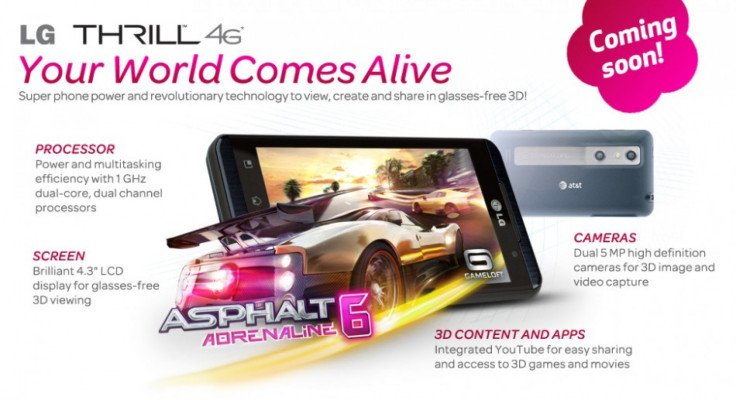Apple iPhone 5 faces threat from glasses-free 3D viewing enabled phones HTC EVO 3D and LG Thrill 4G

Rumor that Apple will fit its soon-to-be-launched iPhone 5 and upcoming iPad 3 with glasses-free 3D capability, has been circulating since Apple was accorded a patent for the technology last year.
Apple received a patent related to glasses-free 3D viewing technology in 2010 under the title Three-dimensional display system. The technology ascertains the position of a viewer and determines the left and right eye locations, and then uses the information to navigate the pixels to a particular spot on screen which reflects it back to respective left and right eye locations. This would allow users to watch 3D without glasses.
However, Apple has not utilized the technology as yet in any of its devices. As Apple gears to launch a revolutionary iPhone 5, speculation about the technology being inserted in the device is evident in the websphere.
While Apple muses over the viability of adding such a fixture to iPhone 5, LG and HTC have already launched two Android smartphones which feature glasses-free 3D viewing.
The two phones have beaten Apple in the 3D game with their devices the HTC EVO 3D and LG Thrill 3D 4G also called LG Optimus 3D.
HTC EVO 3D runs on Sprint network while LG Thrill 3D 4G will run on AT&T network. HTC EVO 3D was launched recently but the release date of LG Thrill 3D is still in wraps.
LG Thrill 3D 4G sports a 4.3-inch 3D LCD display with 800x480 screen resolution. HTC EVO 3D also features a 4.3-inch 3D display but offers a higher resolution of 960x540 pixels.
LG Thrill 3D is powered by a 1GHz dual-core TI OMAP chipset while HTC EVO 3D runs on a 1.2GHz Qualcomm processor.
HTC EVO 3D optimizes Android 2.3 or Gingerbread while LG Thrill is based on Android 2.2 or Froyo but can be upgraded to Android 2.3.
LG Thrill 3D comes equipped with dual 5MP stereoscopic camera which allows users to capture 1080p 2D videos and 720p 3D videos. HTC EVO 3D also features dual 5MP stereoscopic camera which allows users to shoot 720p videos in both 2D and 3D format. Both the phones also pack in front-facing cameras.
HTC EVO 3D offers 512MB RAM with 1GB internal memory while LG Thrill 3D 4G features 512MB RAM and 8GB internal storage.
Both the phones offer glasses-free 3D viewing capability.
On the dimension front, HTC EVO 3D is 0.47-inch thick and weighs about 6 oz while LG Thrill 4G 3D is 0.46-inch thick and weighs about 5.9 oz.
Thus, both phones offer glasses-free 3D option which acts like a key differentiator from other standard features found in the current breed of smartphones.
While there is no certainty about whether Apple will fit iPhone 5 with glasses-free 3D capability, currently users can still watch glasses-free 3D content on iPhone 4 via a front-facing camera hack.
A French group of researchers called the Engineering Human-Computer Interaction Research Group were able to achieve this on iPhone 4 and iPad 2. The group uses a technology called Head-Coupled Perspective (HCP) which uses the front-facing camera as a head-tracker. It gauges the user's head position and accordingly adapts the perspective of 3D scene to offer glasses-free 3D viewing.
Apple's iPhone 5 which is rumored to arrive this September is speculated to feature a larger 3.7-inch curved glass screen, edge-to-edge display, 8MP camera with dual-LED flash, A5 dual-core processor and a SIM-less worldphone design. However, all these rumored features are offered by LG Thrill 4G 3D and HTC EVO 3D and in many areas superseded. But most of these phones have a USP which iPhone 5 cannot match with the glasses-free 3D viewing option.
Here is a video of the glasses-free 3D viewing on Apple iPhone 4 offered by the French research group through a front-camera hack:
© Copyright IBTimes 2024. All rights reserved.











